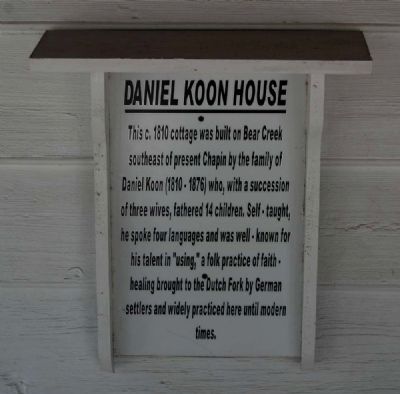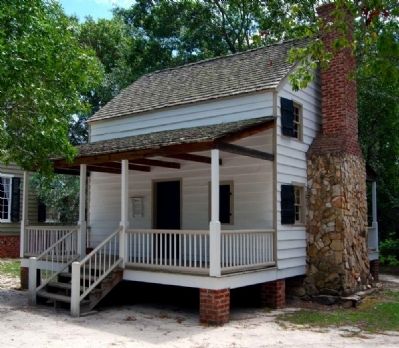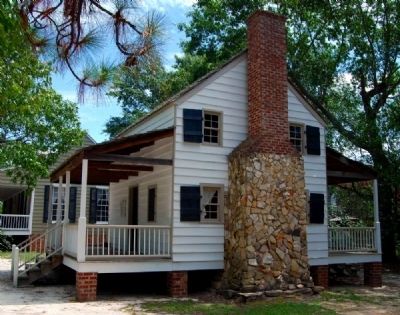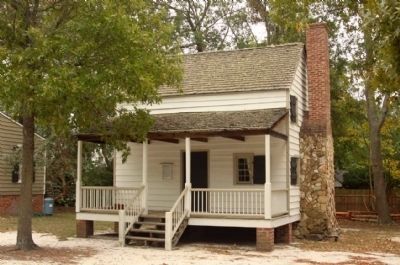Lexington in Lexington County, South Carolina — The American South (South Atlantic)
Daniel Koon House
Topics. This historical marker is listed in this topic list: Notable Buildings. A significant historical year for this entry is 1810.
Location. 33° 59.217′ N, 81° 14.433′ W. Marker is in Lexington, South Carolina, in Lexington County. Marker can be reached from Fox Street south of Columbia Avenue (U.S. 378), on the right when traveling south. Building is on the grounds of the Lexington County Museum. Touch for map. Marker is at or near this postal address: 231 Fox Street, Lexington SC 29072, United States of America. Touch for directions.
Other nearby markers. At least 8 other markers are within walking distance of this marker. Laurence Corley House (within shouting distance of this marker); Hazelius House (within shouting distance of this marker); Oak Grove Schoolhouse (within shouting distance of this marker); Post Office (within shouting distance of this marker); Lutheran Classical and Theological Seminary (within shouting distance of this marker); John Fox House (within shouting distance of this marker); a different marker also named John Fox House (about 300 feet away, measured in a direct line); Kitchen (about 400 feet away). Touch for a list and map of all markers in Lexington.
Additional commentary.
1. James Daniel Koon's Three Wives
James Daniel Koon born 11 August 1810 died June 1871 married 1) Eve Margaret Eargle born 28 November 1810 died 2 June 1838; married 2) Eve Margaret (Peggy) Eargle born 3 February 1816 and married 3) Annie Melvina Eargle born 24 July 1839 died 22 April 1907. First wife buried Koon Family Cemetery, now destroyed. Third wife buried at Bethcar Baptist Church, between Wagner and New Holland, SC. (Source: http://dutchforkchapter.org/html/koon.html.)
— Submitted August 28, 2009, by Brian Scott of Anderson, South Carolina.
2. Daniel Koon and "Using"
The Dutch Germans who settled "in the fork" were often intelligent, well-read and hardworking. One example was Daniel Koon of the Chapin area who was born in 1810 and died in 1876.
Daniel was well read and had a library of books. He taught children to fear his books in order to protect them from handling. He could speak four languages.
He was also an expert craftsman and wheelwright, but his greatest reputation lay in his strange talents of being able to stop bleeding, soothing burns, curing thrash and talking children into deep, restful sleep. He admitted to being a "faith healer" but insisted he was no doctor nor did he pretend to have any special powers. Nevertheless, when neighbors sent for him night or day he hurried to them. He said he could soothe the ill by reassurance. He never refused sharing his talents nor did he ever charge for his services.
He had a widespread reputation for mystery and may have contributed to this image by clever manipulation. When Sherman troop's came to the Koon house at the end of the Civil War, they went to his barn to take his two mules and a horse. As they opened the gate, the animals burst free, knocking the soldiers out of the way and disappearing into the woods. The soldiers ransacked Koon's smokehouse and when his dog's began growling at them the soldiers shot at the dogs. They missed each time and the dogs escaped. Koon went to a wash pot, reached down into it and came up with a handful of pistol balls. He told the soldiers their bullets had gone to the wash pot. The frustrated soldiers hurriedly grouped and departed promptly taking no other belongings. The horse and mules came home two weeks later. (Source: From Lake Murray: Legend and Leisure 2nd Edition by Coy Bayne.)
— Submitted August 28, 2009, by Brian Scott of Anderson, South Carolina.
Credits. This page was last revised on January 10, 2021. It was originally submitted on August 28, 2009, by Brian Scott of Anderson, South Carolina. This page has been viewed 2,021 times since then and 62 times this year. Last updated on August 8, 2019, by David Bickley of Lexington, South Carolina. Photos: 1, 2, 3. submitted on August 28, 2009, by Brian Scott of Anderson, South Carolina. 4. submitted on September 21, 2011, by Mike Stroud of Bluffton, South Carolina. • Bernard Fisher was the editor who published this page.



